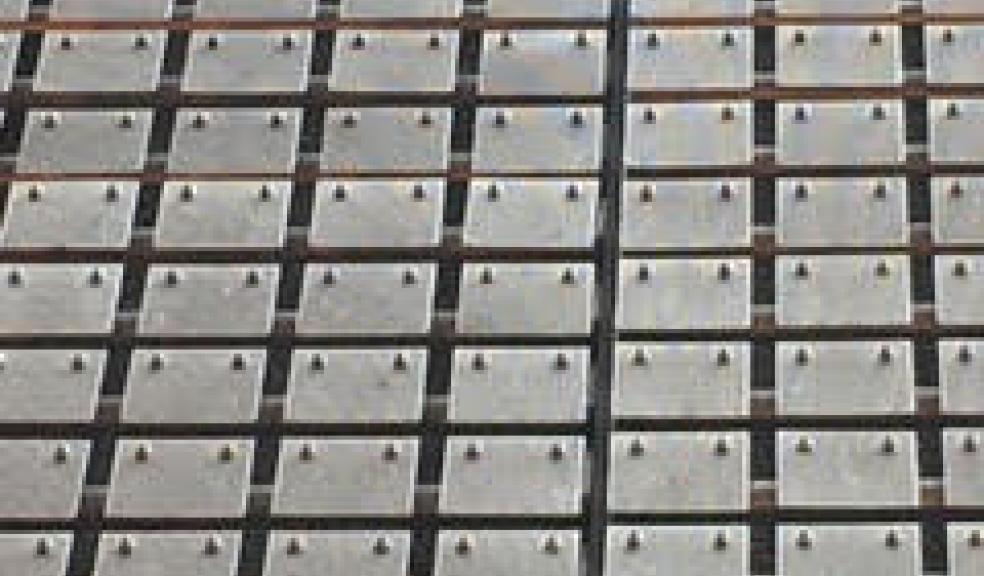
Spectacular ‘kinetic wall’ to adorn flagship building at Oceansgate development
Is it an architectural feature, or a work of art? Either way, it’s going to be stunning. On the façade of Plymouth’s Endeavour House, the flagship building of the Oceansgate development, there will be a silvery screen that ripples like the water of the nearby English Channel, giving a shimmering, ever-moving spectacle. It symbolises Plymouth’s historic connection with the sea, and is also a visual representation of the winds of change and the turning of the tide, as the city shifts its focus towards the wide open spaces of its waterfront, and the massive economic potential of the UK’s first exclusively marine enterprise zone.
The kinetic wall installation will be nearly six metres wide and more than seven metres high, and will be made up of 1,786 small aluminium squares, hanging from steel wires stretched horizontally over a steel frame. The squares are light enough to be lifted by the wind, and as they reflect the light, they mimic the rippling movement of water.
The Endeavour House building marks the entry into the Oceansgate Marine Industrial Park; the multi-million pound transformation of a redundant former Royal Navy site at South Yard, Devonport, into a prime location for marine business and technology. Already well known to Plymothians, it is also attracting interest and investment from all over the country. Endeavour House is at the inland first phase of the development; phases two and three will take it progressively right up to the waterfront, giving companies direct deep-water access to the open sea. The city is literally opening up and reconnecting with what is arguably its most valuable asset; its gateway to the rest of the world, with the aim of creating a global marine enterprise zone.
This couldn’t be more appropriate for the main architect behind Oceansgate. Graham Lobb, founder of the Form Design Group, has been at the helm of many of Plymouth’s regeneration projects including the Barbican and Sutton Harbour. When the company was commissioned by Midas Construction and Plymouth City Council to design Oceansgate, Graham wanted to incorporate an exciting, innovative feature that would reflect the forward-looking spirit of the development, as well as the continuation of Plymouth’s marine history.
“The installation of the kinetic wall is driven by the ambition to celebrate the connection of Plymouth’s historic South Yard with the sea,” he said. “So, the search began for a contemporary language in the buildings that also resonated with the industrial activities from the age of sail. We were intrigued by the inherent aspects aspects of sail and the means of harnessing the power of the wind.”
This led Graham and his colleagues to the work of the Californian environmental artist Ned Khan, known for creating installations which give blank facades a sense of life. His technique of hanging small aluminium plates, or ‘shingles’, from a horizontal line has been used to spectacular effect on the Debenhams building in London’s Oxford Street. They visited the building and saw how its façade ripples like water and also replicates the movement of sails as the wind is captured, providing the effect they were seeking. They proposed the idea of a smaller-scale installation to Plymouth City Council, who bought into the idea.
The leader of the council, Ian Bowyer, said: "We’re really excited by this artistic feature. It’s adventurous and pioneering, which is totally in keeping with what Oceansgate is all about.
“As soon as I heard about it, I was really intrigued about how they were going to do this – but here we are – rippling water going up a wall.
“The whole thing is incredible. This is a Plymouth design firm testing the boundaries right here, on an exciting site in Britain’s Ocean City".
A specialist company, Dane Architectural Systems, have the licence to install Ned Khan’s concepts in the UK. They were employed by the contractors, Midas Construction, and Form Design worked with them to develop the design for Plymouth’s own kinetic wall.
The façade will be assembled on-site at Endeavour House, starting on March 12th and taking four or five days. Each of the 1,786 aluminium shingles will be put in place individually, building up the installation piece by piece.
Graham Lobb explained: “Once in place there is no maintenance required and it will weather quite naturally in the challenging marine micro-climate. There is a minimal audible output from the screen that can only be perceived as the wind moves over the shingles. That’s insulated from the workplace by masonry piers that encase the frame.”
Graham is full of praise for Plymouth City Council’s support for the innovative project. “They have been brave enough to embrace these new ideas and technologies, moving forward. We could not have delivered this if the dialogue and support had not been positive in finding a way to herald a new age of marine enterprise in the city. The screen is only one part of keeping faith with the industrial heritage of the Yard. The scheme as a whole is helping to attract new businesses into Plymouth. This is Plymouth taking a proactive and pioneering approach to new areas of employment that reinforces its strong profile as an Ocean City, and is already attracting national interest.
“We hope our enthusiasm and belief in the Oceansgate initiative will contribute to its success and help maintain Plymouth’s position in the marine economy by reinventing the working life of South Yard whilst respecting its history.
“And we also hope the kinetic wall will bring a little delight to the passer-by and the users of this building, on a daily basis.”











